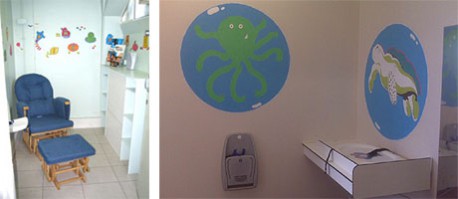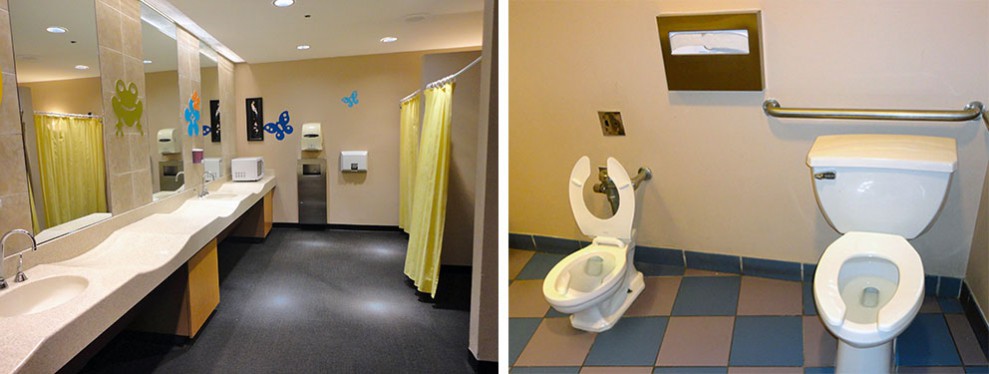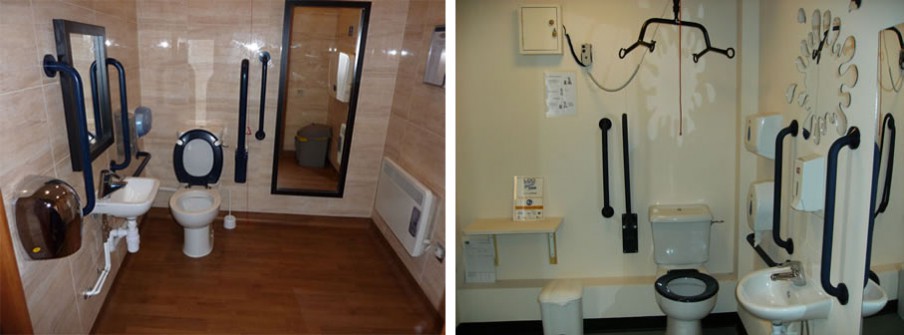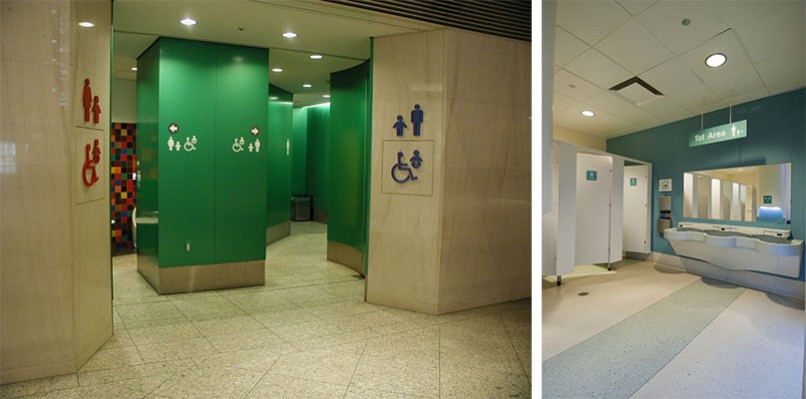Public toilet (also called a bathroom, restroom, latrine, comfort room, powder room, toilet room, washroom, water closet, W.C., public lavatory, lav, convenience)
The idea of inclusive design or universal design, is that it is design for everybody, regardless of gender, age, ability or physical mobility. This blog post will focus on how design can address all of these elements, I will be using the public lavatory as an example; a convenience universally required by all at some-point. Years ago it was quite common to find these toilets as separate buildings located on street level. However, today there is even a London tour; “Loo tours” which charge tourists to see some of the older lavatories that are no longer open to the public. A survey in 2007 found that there were 15,000 people to every 1 public toilet in Paris, 17,000 for London and infinite number for New York.
Many public toilets are now located in restaurants, cafes, department stores or hotels. Cities such as London work in collaboration with established businesses to provide public toilet facilities to the general public without having to be a customer.
The main aim here however is not to focus on the lack of access or availability but on good design and the issues that should be considered when making public toilets truly inclusive. This goes beyond the inclusion of compulsory elements such as handle bars or enough space for a wheelchair in an accessible toilet. A good designer knows that to create a positive impression, the design involves research, which in turn should involve the views and feedback of the users. Some of the views and experiences on using public lavatories from different user types include the following statements.
“I usually have to ask for directions wherever I go. I find sign-age the main problem.”
“Interiors of toilets need to have a contrast in the paint (door frames a different colour to easily identify the toilet door) Don’t use white tiles, although very clinical looking they give too much glare.”
“I always had to leave my baby outside the toilet door as I couldn’t fit the stroller in with me. They should also have small sinks so little kids can wash their hands”
“A couple of times we have found ourselves in a restaurant or somewhere which doesn’t have changing for dads so we make a very public protest change on the chair. We are left with no choice but to do that really.”
“The toilets are too small and the tiled floors always end up too slippery”
Every single one of us will have our own personal perspective on the functional adequacy of public lavatories. However, it is good to note some examples of public lavatory design which addresses the principles behind inclusive design. Brighton and Hove are one of the first local UK councils to introduce family friendly gender neutral toilets for public use. The examples below shows public toilets with baby changing facilities in both the male and female toilets. This has also been decorated in such a way to make it child friendly.
Brighton and Hove baby changing rooms in public toilets showing mural designs.
The family friendly public toilets at Westfield Garden Plaza, New Jersey include different height toilets and curtained areas for nursing mothers.
The examples above and below shows considerately designed accessible toilets for a mixture of needs and integration of accessible fixtures into the general design. Further consideration to design is shown below with integrated fixture for a child with clear sign-age.
The images above show some good examples of sign-age. Euro tunnel uses light to also act as a way for finding the lavatories. The toilets at Tokyo station and the Field Museum in Chicago above have clear sign-age and appropriate use of colour for defining the space.
The images above represent what can be created if the use of space is taken into consideration when designing any interior space. For public toilets, a more universal approach would also improve the normal perception to create an inclusive and user friendly design for all.
References
Images
Brighton and Hove City (N.D) Norton Road public toilets [online image]. Available from: http://www.brighton-hove.gov.uk/content/leisure-and-libraries/public-toilets/family-friendly-public-toilets [Accessed 28/04/2014].
Euro Tunnel (2013) Entrance to toilets [online image]. Available from: http://www.loo.co.uk/winners/2012/showcase2012.php [Accessed 28/04/2014].
Euro Tunnel (2013) Path to toilets [online image]. Available from: http://www.loo.co.uk/winners/2012/showcase2012.php [Accessed 28/04/2014].
Hart, C. (2006) Bathroom [photograph] Adaptive Environments, Boston MA.
Hart, C. (2006) Kinder sign [photograph] Adaptive Environments, Boston MA.
Hart, C. (2006) Urinal partitions [photograph] Adaptive Environments, Boston MA.
Hart, C. (2006) Urinals [photograph] Adaptive Environments, Boston MA.
Hart, C. (2006) Tokyo station [photograph] Adaptive Environments, Boston MA.
JD Wetherspoon (2013) The Bell –Accessible toilets [online image]. Available from: http://www.loo.co.uk/winners/2012/showcase2012.php [Accessed 28/04/2014].
Poulton Church (2012) Accessible toilets [online image]. Available from: http://www.loo.co.uk/winners/2012/showcase2012.php [Accessed 28/04/2014].
Westfield Garden Plaza (2013) Family changing [online image]. Available from http://www.bestrestroom.com/us/press/2013-finalists-images.asp : [Accessed 28/04/2014].
Westfield Garden Plaza (2013) Bathroom [online image]. Available from http://www.bestrestroom.com/us/press/2013-finalists-images.asp : [Accessed 28/04/2014].
Interviews
Carter, A. (2007). Public Conveniences: How convenient are they? [Interview] 3rdth June 2007
Cleveland, M. (2007). Public Conveniences: How convenient are they? [Interview] 14th May 2007
Davidson, M. (2007). Public Conveniences: How convenient are they? [Interview] 20th May 2007
Emmanuel. (2007). Public Conveniences: How convenient are they? [Interview] 15th May 2007
Goodacre, S. (2007). Public Conveniences: How convenient are they? [Interview] 14th May 2007
Harvey, S. (2007). Public Conveniences: How convenient are they? [Interview] 20th May 2007
Michaelson, M. (2007). Public Conveniences: How convenient are they? [Interview] 20th May 2007







